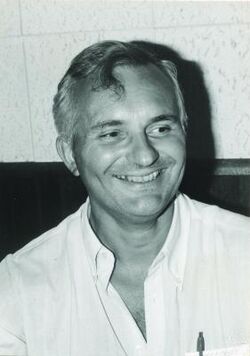Biography:Jacques-Louis Lions
Jacques-Louis Lions | |
|---|---|
 Lions in 1970 | |
| Born | 2 May 1928 Grasse, Alpes-Maritimes, France |
| Died | 17 May 2001 (aged 73) Neuilly-sur-Seine, France |
| Alma mater | École normale supérieure University of Nancy |
| Known for | Asymptotic homogenization Interpolation space Lion's theorem Lions–Magenes lemma Aubin–Lions lemma Duvaut–Lions formulation |
| Awards | W. T. and Idalia Reid Prize (1998) ForMemRS (1996) Harvey Prize (1991) Japan Prize (1991) John von Neumann Prize (1986) ICM Speaker (1958, 1970, 1974) Peccot Lecture (1958) |
| Scientific career | |
| Fields | Mathematics |
| Institutions | École Polytechnique Collège de France |
| Doctoral advisor | Laurent Schwartz |
| Doctoral students | Alain Bensoussan Jean-Michel Bismut Haïm Brezis Erol Gelenbe Roland Glowinski Roger Temam |
Jacques-Louis Lions (French: [ljɔ̃ːs];[1] 2 May 1928 – 17 May 2001) was a French mathematician who made contributions to the theory of partial differential equations and to stochastic control, among other areas. He received the SIAM's John von Neumann Lecture prize in 1986 and numerous other distinctions.[2][3] Lions is listed as an ISI highly cited researcher.[4]
Biography
After being part of the French Résistance in 1943 and 1944, Jacques-Louis Lions entered the École Normale Supérieure in 1947. He was a professor of mathematics at the University of Nancy, the Faculty of Sciences of Paris, and the École Polytechnique.
In 1966 he sent an invitation to Gury Marchuk, the soviet mathematician to visit Paris. This was hand delivered by Général De Gaulle during his visit to Akademgorodok in June of that year.[5]
He joined the prestigious Collège de France as well as the French Academy of Sciences in 1973. In 1979, he was appointed director of the Institut National de la Recherche en Informatique et Automatique (INRIA), where he taught and promoted the use of numerical simulations using finite elements integration. Throughout his career, Lions insisted on the use of mathematics in industry, with a particular involvement in the French space program, as well as in domains such as energy and the environment. This eventually led him to be appointed director of the Centre National d'Etudes Spatiales (CNES) from 1984 to 1992.
Lions was elected President of the International Mathematical Union in 1991 and also received the Japan Prize and the Harvey Prize that same year.[3] In 1992, the University of Houston awarded him an honorary doctoral degree. He was elected president of the French Academy of Sciences in 1996 and was also a Foreign Member of the Royal Society (ForMemRS)[6] and numerous other foreign academies.[2][3]
He has left a considerable body of work, among this more than 400 scientific articles, 20 volumes of mathematics that were translated into English and Russian, and major contributions to several collective works, including the 4000 pages of the monumental Mathematical analysis and numerical methods for science and technology (in collaboration with Robert Dautray), as well as the Handbook of numerical analysis in 7 volumes (with Philippe G. Ciarlet).
His son Pierre-Louis Lions is also a well-known mathematician who was awarded a Fields Medal in 1994.[7] Both father and son have received honorary doctorates from Heriot-Watt University in 1986 and 1995 respectively.[8]
Books
- with Enrico Magenes: Problèmes aux limites non homogènes et applications. 3 vols., 1968, 1970
- Contrôle optimal de systèmes gouvernés par des équations aux dérivées partielles. 1968
- with L. Cesari: Quelques méthodes de résolution des problèmes aux limites non linéaires. 1969
- with Roger Dautray: Mathematical analysis and numerical methods for science and technology. 9 vols., 1984/5; translated from Analyse mathématique et calcul numérique pour le sciences et le techniques by Ian Sneddon[9]
- as editor with Philippe Ciarlet: Handbook of numerical analysis. 7 vols.[10]
- with Alain Bensoussan, Papanicolaou: Asymptotic analysis of periodic structures. North Holland 1978
- with Roland Glowinski and Raymond Trémolières: Numerical analysis of variational inequalities, North Holland 1981[11] 2011 pbk edition
- Contrôlabilité exacte, perturbations et stabilisation de systèmes distribués: Contrôlabilité exacte. tome 1. Masson. 1988. ISBN 9782225814778. https://books.google.com/books?id=NE_vAAAAMAAJ.[12]
- Contrôlabilité exacte, perturbations et stabilisation de systèmes distribués: Perturbations. tome 2. Masson. 1988. ISBN 9782225814747. https://books.google.com/books?id=G07vAAAAMAAJ.[12]
- with John E. Lagnese: Modelling Analysis and Control of Thin Plates.
See also
References
- ↑ CORE Fields Medal Talk: Pierre-Louis Lions on Mean Field Games
- ↑ 2.0 2.1 Jacques-Louis Lions. Casinapioiv.va. Retrieved on 9 May 2016.
- ↑ 3.0 3.1 3.2 Jacques-Louis LIONS. isces.org
- ↑ Thomson ISI. "Lions, Jacques-Louis, ISI Highly Cited Researchers".
- ↑ Impagliazzo, John; Proydakov, Eduard (2011) (in en). Perspectives on Soviet and Russian Computing: First IFIP WG 9.7 Conference, SoRuCom 2006, Petrozavodsk, Russia, July 3-7, 2006, Revised Selected Papers. Springer. ISBN 9783642228162. https://books.google.com/books?id=-jSqCAAAQBAJ&q=Akademgorodok+Cybernetics&pg=PA239. Retrieved 1 March 2018.
- ↑ Ciarlet, P. G. (2002). "Jacques-Louis Lions. 2 May 1928 – 17 May 2001". Biographical Memoirs of Fellows of the Royal Society 48: 275–287. doi:10.1098/rsbm.2002.0015.
- ↑ Hoffmann, Ilire Hasani, Robert. "Academy of Europe: Lions Pierre-Louis". http://www.ae-info.org/ae/User/Lions_Pierre-Louis.
- ↑ "Heriot-Watt University Edinburgh: Honorary Graduates". http://www1.hw.ac.uk/graduation/honorary-graduates.htm.
- ↑ Tulovsky, Vladimir (1990). "Review of Mathematical Analysis and Numerical Methods for Science and Technology, Volume 2: Functional and Variational Methods by Robert Dautray and Jacques-Louis Lions; Ian N. Sneddon, trans.)". SIAM Review 32: 191–192. doi:10.1137/1032037. https://www.proquest.com/openview/a095a3b87627cfdb31bcf91d8806a6c0/1?pq-origsite=gscholar&cbl=30748.
- ↑ Ciarlet and J.-L. Lions were co-editors for Elsevier's series Handbook of Numerical Analysis — after the death of Lions, Ciarlet became the sole editor for the series. "Handbook of Numerical Analysis, Volume 8, 1st edition". https://www.elsevier.com/books/handbook-of-numerical-analysis/ciarlet/978-0-444-50906-2.
- ↑ Hager, William W. (1983). "Book Review: Numerical analysis of variational inequalities". Bulletin of the American Mathematical Society 8: 100–103. doi:10.1090/S0273-0979-1983-15096-6.
- ↑ 12.0 12.1 Russell, David L. (1990). "Review: Controlabilité Exacte, Perturbations et Stabilisation de Systèmes Distribués, by J.-L. Lions". Bull. Amer. Math. Soc. (N.S.) 22 (2): 353–356. doi:10.1090/s0273-0979-1990-15909-9. https://www.ams.org/journals/bull/1990-22-02/S0273-0979-1990-15909-9/S0273-0979-1990-15909-9.pdf.
External links
- Obituary on SIAM
- Obituary in Automatica
- O'Connor, John J.; Robertson, Edmund F., "Jacques-Louis Lions", MacTutor History of Mathematics archive, University of St Andrews, http://www-history.mcs.st-andrews.ac.uk/Biographies/Lions_Jacques-Louis.html.
- Jacques-Louis Lions at the Mathematics Genealogy Project
 |

